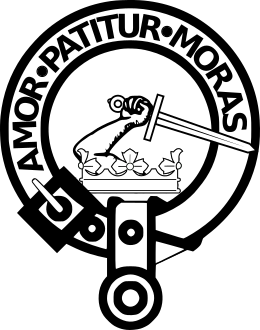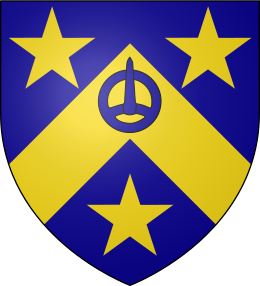Clan Lumsden facts for kids
Quick facts for kids Clan Lumsden |
|||
|---|---|---|---|

Crest: Issuant from a crest coronet Or a naked arm grasping a sword Proper
|
|||
| Motto | Amor Patitur Moras (Love endures delays) | ||
| Profile | |||
| Region | Borders | ||
| District | Berwickshire | ||
| Chief | |||
 |
|||
| Gillem Lumsden of that Ilk and Blanerne | |||
| Chief of the Name and Arms of Lumsden | |||
| Seat | Stapely House, Berkshire | ||
| Historic seat | Blanerne Castle | ||
| Last Chief | Gillem Lumsden of that Ilk | ||
|
|||
Clan Lumsden is a Scottish family group, known as a 'clan', from the Lowlands of Scotland. Clans are like large families or tribes. They often share a common ancestor and a strong sense of identity.
Contents
History of Clan Lumsden
Where the Clan Began
The Lumsden family name comes from a place called Lumsden. This area is in Berwickshire, Scotland. It was first mentioned around the year 1100. King Edgar of Scotland gave the villages of Lumsden and others to Coldingham Priory.
The first people recorded with the Lumsden name were Gillem and Cren de Lummisden. They were mentioned in official papers between 1166 and 1182. Another person, Gilbert de Lumisden, was a witness to important documents from 1249 to 1262.
In 1296, Adam de Lumsden and his son, Roger, were listed on the Ragman Rolls. This was a list of Scottish nobles who swore loyalty to King Edward I of England. Gilbert, a descendant of Adam, is considered the first recognized chief of Clan Lumsden. He married a woman who was the heir to Blanerne. This happened around 1329. He even adopted her family's special symbol: an eagle eating a salmon!
Gilbert had two sons. His older son, also named Gilbert, led to many Lumsden families. These include the Lumsdens of Blanerne, Airdrie, and others. His younger son, Thomas, owned lands in Fife and Aberdeenshire. His family line includes the Lumsdens of Cushnie-Lumsden and Tillycairn.
The 1600s: Wars and Changes
In 1672, the main Lumsden family line did not officially register their family symbols (called 'arms'). However, two other branches of the family did. These were Alexander Lumsden of Cushnie and Sir James Lumsden of Innergellie. Today, many Lumsden families who have official arms can trace their history back to these two men.
A famous Lumsden from this time was James Lumsden. He was a military officer who fought for the King of Sweden in the Thirty Years' War. This was a big war in Europe. Later, James and his brother, William, came back to Scotland. They fought for the King's side during the Scottish Civil War in the 1640s.
The 1700s: Jacobite Risings
During the Jacobite Rising of 1745, a man named Andrew Lumsden played an important role. He was the secretary to Prince Charles Edward Stuart, also known as 'Bonnie Prince Charlie'. The Prince was trying to reclaim the throne for his family.
After the Battle of Culloden in 1746, the Jacobites lost. Andrew Lumsden had to flee to Rome. There, he became a secretary to Prince Charles's father, James Francis Edward Stuart. Andrew Lumsden later returned to Scotland in 1773. He was pardoned by the government in 1778.
Castles and Clan Homes
- Blanerne Castle in Berwickshire was the main home of the Lumsden chiefs. The clan gained this castle in the 1300s.
- Pitcaple Castle in Cushnie and Tillycairn Castle in Cluny were also owned by parts of the Clan Lumsden.
See also
Images for kids


